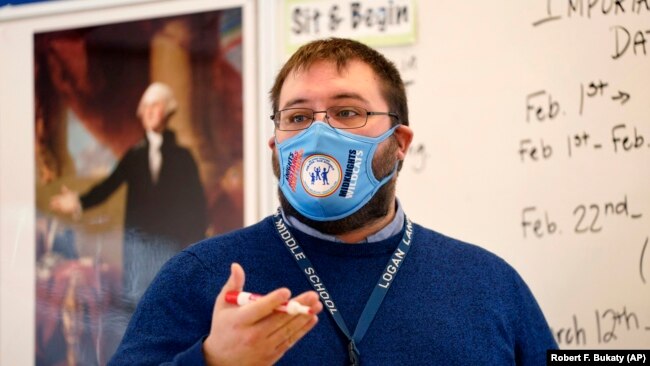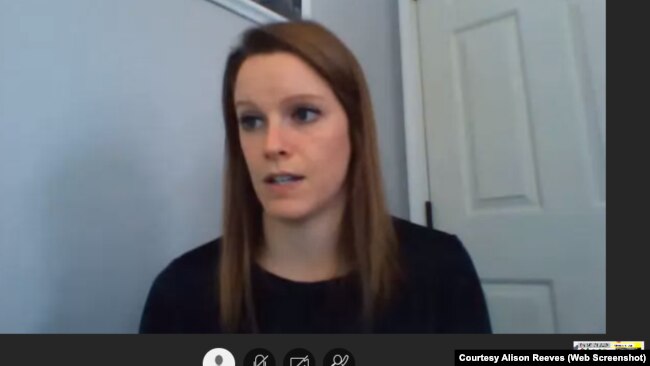先生視点だけの内容になっているので、残念です。
時間の短縮を状内容の工夫で乗り切ろうとする苦労が伺えます。
生徒にとっては、どうなのでしょうか?
今日のVOA,教育現場の今。
授業時間を短縮したことで、学生はどんなことを学ぶのか?
What Lessons Will Students Learn from Reduced Class Time?
2 hours ago /2021/02/21
アメリカの公立高校の教師のほとんどは、今のような学年になるとは思ってもいませんでした。2020年3月には全国の校舎が閉鎖されました。教育はオンライン化され、通信教育はその後も続きました。
全国の教師はすぐに、生徒にいつものように多くの教材を教えることができないことに気がつきました。教育者は、どのような内容をカバーし、何を落としてもよいかを選択しなければなりませんでした。
そのため、時が経つにつれて、英語の教師は、彼らの教育計画からいくつかの本や執筆プロジェクトをカットし始めました。
歴史の教師は、いくつかの時代のカバー範囲を縮小し始めました。
理科の先生は、学校の実験室が使えなくなったために、実験をベースにした作業を取り除かなければなりませんでした。
家で仕事をしながら勉強についていけた生徒もいましたが、多くの生徒は学校にいないことに苦労しました。今年度は、多くの教師が生徒に直接会ったことすらありません。
アリソン・リーブスさんは、ワシントンD.C.から約30キロ離れたバージニア州フェアファックスの高校でスペイン語の教師をしています。学年の今頃になると、彼女は普段から生徒のことをよく知っていると言っていました。しかし、今年は違います。
「彼らが誰なのかは大体分かりますが、実質的には違うことが分かります。 彼らが質問に答えるときの声は知っていますが、顔がどんな風に見えるのか、それ自体は分かりません。」
彼女は、遠隔学習は特に語学クラスの学生にとって難しいと言います。
通常の学年の初めには、友達の前で間違った言葉を言うのを恥ずかしがる生徒もいると彼女は説明しました。しかし、しばらくすると、彼らはクラスの全員が新しい言語を学んでいることを理解します。その時点で、彼らはもう恥ずかしがることはありません。
しかし、家庭ではもっと恥ずかしがり屋なのだとリーブスさんは言います。彼らは親の前で間違いをすることを心配しています。
そのため、今年は例年よりもスピーキングの優先順位を低くしたとリーブスさんは言います。彼女は、生徒たちがスペイン語で書くことを学ぶことに重点を置いています。さらに、通常、生徒たちには2つの異なる過去形を学習させています。今年は現在時制に重点を置いています。
教え方を変えたのはリーブスさんだけではありません。
ワシントンD.C.から約15キロ離れたメリーランド州シルバースプリングの高校で、アドバンスドプレースメントのアメリカ史を教えているタッシー・ザーナーさんは、10年近く教えています。
学年の終わりに、彼女の生徒は全国の歴史のテストを受けます。大学はこのテストの点数をもとに入学の意思決定を行います。
ザーナーさんは、アメリカの歴史のさまざまな部分に費やす時間を減らしています。例えば、彼女は通常、19世紀の最後の部分について教える18のクラス期間を費やしています。それは3週間以上かかります。今年は4時間に短縮しました。
その結果、生徒のテストの点数には真の能力が表れないものもあると彼女は考えています。ザーナーさんは、彼女の学校の指導者は、今年のテストのスコアを心配していないと言いました。しかし、彼女の生徒は心配しています。
「私にはテストの点数が欲しい生徒がいます。彼らは非常に気にしています。そして、彼らに同じような情報を与えることができないことと、実際の教室で行うのと同じような厳しさは、私にとっても彼らにとっても非常に困難でした。」
ジェイク・スタンフォードさんは、カリフォルニア州のパームスプリングス高校で英語を教えています。教職に就いて13年になります。彼の学校はパンデミックのためにスケジュールを変更しました。
そのため、彼が通常生徒に与えるはずだったライティングプロジェクトに大きな影響を与えてしまいました。
作文プロジェクトには多くの時間が必要です。生徒たちは論文を書いたり書き直したりして、完成するまでに何度も書き直します。スタンフォードさんは、通常、学生に年間24本の論文を書くように要求すると言いました。しかし、今年は違います。
「それを期待しようとするのは現実的ではありませんでしたし、私はできていませんでした。そして、同僚からも同様に聞いています。」
スタンフォードさんは、学生が通常の半分の数のライティングプロジェクトを行うといいます。
コロラド州デンバーで英語を教えるクリスティン・エスピノサさん。彼女は今年、彼女の教育計画から彼女の好きなプロジェクトのいくつかを削除しなければならなかったと言います。授業時間が90分だったと彼女は言います。今では、毎回の授業で20分ほど生徒に会います。
しかし、何人かの先生方は、新体制での教育的な成功を報告しています。ジェイク・スタンフォードさんは、彼の生徒の何人かが過去よりも良いパフォーマンスをしていると言いました。コロナウイルスの健康危機のために、彼らは他の多くのことをしていません。
「彼らは素材を吸収し、非常に迅速にとてもとても高いレベルのスキルを獲得しています。」
アリソン・リーブスさんは 大学が入学を決める際に 高校教育におけるパンデミックの影響を 考慮してほしいと話します。
彼女は、授業時間や教科の範囲が狭くなっても、全体的に生徒の将来に希望を持っています。彼らは困難な教育状況に対処する方法を学んでいます。「それは本当に多くの内容よりもはるかに先を行くことになるだろう 」と彼女は言います。
タッシー・ザーナーさんも同様の考えを示しています。
「私の学校には、仕事をして家族を養い、多世代の家庭の世話をしている生徒がいます。それでも毎日顔を出して授業に出て仕事をしています。素晴らしいことです。」と述べています。
What Lessons Will Students Learn from Reduced Class Time?
 Logan Landry speaks to his class at the Bruce M. Whittier Middle School in Maine, Jan. 29, 2021. Many of the nation's teachers have given up on covering all the material normally included in their classes and instead are cutting lessons. (AP Photo/Robert F. Bukaty)
Logan Landry speaks to his class at the Bruce M. Whittier Middle School in Maine, Jan. 29, 2021. Many of the nation's teachers have given up on covering all the material normally included in their classes and instead are cutting lessons. (AP Photo/Robert F. Bukaty)
Most public high school teachers in the United States never expected a school year like the current one. School buildings closed across the country in March of 2020. Education went online and distance learning has continued since.
Teachers around the country quickly found they would not be able to teach as much material as usual to their students. The educators had to make choices about what content to cover and what could be dropped.
So, over time, English teachers began cutting some books and writing projects from their teaching plans.
History teachers began to shrink their coverage of some periods.
Science teachers had to remove experiment-based work because school laboratories were no longer available.
While some students were able to keep up with their studies while working from home, many struggled without being at school. In the current school year, many teachers have not even met their students in person.
Alison Reeves is a Spanish teacher at a high school in Fairfax, Virginia, about 30 kilometers outside of Washington, D.C. She said by this time in a school year, she usually knows her students well. But this year is different.
“I have gotten a good sense of who they are, but you learn different things virtually. I know their voices when they answer questions, but I don’t know what their face looks like, per se.”
She said distance learning is especially difficult for students in language classes.
At the start of a normal school year, she explained, some students can be shy about saying a word incorrectly in front of their friends. But after a while, they understand everyone in the class is learning a new language. At that point, they are not shy anymore.
But at home, Reeves said, the students are shyer. They worry about making mistakes in front of their parents.
Because of this, Reeves said, she has made speaking less of a priority this year than in past years. She is more centered on helping her students learn to write in Spanish. In addition, she usually has her students learning two different past tenses by now. This year she has centered more on the present tense.
Reeves is not the only teacher changing her teaching plan.
Tassie Zahner teaches Advanced Placement U.S. History at a high school in Silver Spring, Maryland, about 15 kilometers from Washington, D.C. She has been teaching for almost 10 years.
At the end of the school year, her students take a national history test. Colleges use the scores to help make admissions decisions.
Zahner cut how much time she spends on different parts of American history. For example, she usually spends 18 class periods teaching about the last part of the 19th century. That takes over three weeks. This year, she did it in four hours.
As a result, she thinks some of her students’ test scores will not show their true ability. Zahner said the leaders of her school are not that worried about the test scores this year. But her students are.
“I have students who want that score on the exam. They do care very much. And not being able to give them the same kind of information and the same rigor that we do in the real classroom has been very difficult for me and for them.”
Jake Stanford teaches English at Palm Springs High School in California. He has been teaching for 13 years. His school changed its schedule because of the pandemic.
That greatly affected writing projects he would normally give his students.
The writing projects require a lot of time. Students write and rewrite a paper several times before they are finished. Stanford said he normally asks students to write 24 papers over the year. But, not this year.
“It’s just not been realistic to try to expect that. And I have not been able to. And I think that’s what I’ve been hearing from colleagues as well.”
Stanford said his students will do half the usual number of writing projects.
Cristin Espinoza teaches English in Denver, Colorado. She said she had to remove some of her favorite projects from her teaching plan this year. Class time used to be 90 minutes long, she said. Now she sees her students for about 20 minutes each class.
Some teachers, however, are also reporting educational successes within the new structure. Jake Stanford said some of his students are performing better than in the past. Due to the coronavirus health crisis, they don’t have as many other things going on.
“They are absorbing material and gaining a higher level of skill very, very quickly.”
Alison Reeves said she hopes colleges will consider the pandemic’s effects on high school education when they make admissions decisions.
She is hopeful about the future for students, overall, even with less teaching time and subject coverage. They are learning how to deal with difficult educational conditions. “That truly,” she said, “will take you much further than a lot of the content.”
Tassie Zahner expressed similar thinking.
“We have students at my school that are working and helping support their families and taking care of multi-generational households, and still showing up every day and going to class and doing their work. That's impressive.”

